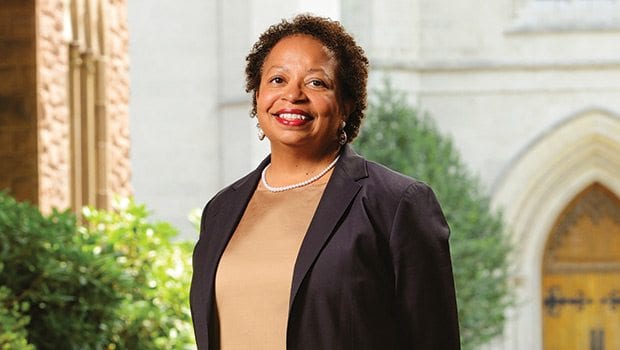More blacks are leading colleges
Program opens doors for women and minority administrators

Joanne Berger-Sweeney had been dean of the College of Arts and Sciences at Tufts University for nearly four years when she considered entering a new program that grooms female and minority administrators for college and university presidencies.
“I actually had to wrestle with myself about my ambitions,” Berger-Sweeney recalled. “But once I decided to join the program, I was actually articulating to myself that I had an ambition to be a college or university president.”
The neuroscientist set her sights on achieving that goal within 18 months. It did not take that long. A year after starting the program, Berger-Sweeney was appointed to lead Trinity College in Hartford, where she has been president since last July.
“I am the first woman president and the first president of color. They got a two-fer,” Berger-Sweeney said with a laugh.
Breaking through
For nearly three decades, the number of women who serve as college presidents or chancellors has grown slowly, from 10 percent in 1986 to 26 percent in 2011, according to the American Council of Education, known as ACE. Its latest survey estimates 13 percent were of color in 2011, and 4 percent were women of color.
In 2013, ACE launched a leadership program designed to increase the number of women and people of color in presidencies. Berger Sweeney joined the first of three groups to go through the mentoring and skill-building, which lasted six to eight months.
Of the 66 participants, eight have since become presidents, according to Kim Bobby, the program’s director. All eight are people of color, five of them women. One is Roslyn Artis of historically black Florida Memorial College, an African American.
Bobby said another eight have advanced to higher positions, such as executive vice chancellor, vice president and vice dean.
“Based on our experience so far, we’re proud to see that we’ve had so many advance, and all of them are people of color — the men too,” Bobby said.
The new female presidents at historically black colleges, besides Artis at Florida Memorial, include Elmira Magnum, the first woman to lead Florida A & M University on a permanent basis, and Pamela Hammond, the interim leader at Virginia State University.
Anthony Owens, national communications director of the United Negro College Fund, said women hold eight of 37 of presidencies at member colleges, or 22 percent. That level is slightly below the 26 percent for women nationwide, but way above the 4 percent for women of color.
“It’s wonderful to have leadership at the top,” said Catherine Hill, vice president of research at the American Association of University Women. “We also want to see leadership throughout the ranks of full professor, throughout the ranks of administration.”
Hill and Berger-Sweeney identified the same crimp in the pipeline that prevents more women from reaching the top — getting promoted to full professor.
“If you don’t get through that process, you’re not going to be considered for the presidency,” Hill said.
Survey data from the American Association of University Professors show that only 9 percent of women in academia were full professors in 2013-14, Hill said.
From a tenured professorship, academics who aspire to the top job can begin moving up the administrative ranks, as Berger-Sweeney did.
“I was an assistant, an associate, a full professor. I was an associate dean at Wellesley (College) for six years. I was a dean of the school for four years” at Tufts, Berger-Sweeney said. “I had, coming into this year presidency, 10 years of progressively increasing administrative experience.”
Berger-Sweeney advised women of color to follow that traditional route to a college presidency.
“That traditional route provides individuals and, particularly, women of color with the credibility that they will need to succeed,” Berger-Sweeney explained.
Each participant in ACE’s Spectrum Executive Leadership Program was assigned a “presidential adviser” or mentor. Berger-Sweeney’s was M. Lee Pelton, president of Emerson College. He peppered her with questions about what kind of college or university she wanted to lead, Berger-Sweeney said.
Participants had monthly conference calls with their presidential adviser and did webinars, readings and studies of current college issues, Bobby said.
At a final meeting, Bobby said, every participant did a mock interview for a presidency, conducted by an executive headhunter. The interviews were videotaped so participants could review their performance and sharpen their interviewing skills.
American Express funded the program, which ended in October, Bobby said, but ACE is seeking additional funding to continue it.
In the meantime, ACE has scheduled a two-day program in April for mid-career administrators — department chairs, directors and associate or assistant deans — who aspire to become presidents. The new program is designed to prepare a pool of candidates for the leadership program when it resumes.
“We know that at the mid-career point, that’s where a lot of people get stalled. They don’t get the right mentorship, sponsorship, advice,” Bobby said. “They end up sometimes in jobs that might be dead end or don’t lead to advancement. And we know that’s where a lot of diversity is.”
With the mid-career program, Bobby said, “We’re hoping that by creating this pipeline you are going to see more diversity in the senior leadership and in the presidency.”






